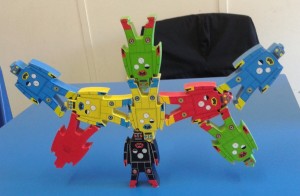We’re taking a little break from Christmassy posts this week – partly because I’m sure, like me, you all have Christmas overload, and partly because I spotted this linky from Kristin Cummings and thought it would be nice to join in as it’s a really useful topic – what’s in your Early Intervention therapy bag?
I’m taking Early Intervention to mean under 3s – these little ones are such fun to work with, but they can be difficult to engage, so it’s always great to have ideas of what to use and what to do!
I find simple toys to be the best with this age-group – I look for things which are hard-wearing (they need to survive being thrown, chewed or stepped on!), versatile and fun! Often sessions with this age-group are a lot less structured and I tend to use toys they have at home or in nursery, as well as some of my own, and just work my targets in to whatever they want to play with. So really I use anything and everything, but here are a few of the things I almost always have with me if I’m working with a 2-3 year old.
- Bubbles. There are so many things you can do with bubbles and most children love them! I won’t go into ideas of things to do in too much detail here though as you can read Elizabeth’s post How to use bubbles in therapy
- Postbox. Kids love to post pictures. This is my postbox which comes with the Early Learning Centre game Pop It In The Post
. Of course you can make your own out of a box, but I find this one is popular with children and almost all the different sets of pictures I have can be posted into it well.
- Books. I use all sorts of different books – lift the flap ones, musical books, I have a book with a puppet in that children like. However, I also use ordinary books with clear, engaging pictures. I particularly like the Usborne look and say series of books for early language work – they have lovely vocabulary pictures as well as a scene where lots of things are happening to talk about.
- Click-clack track. I don’t use this so much now that I’m a travelling therapist as mine is large and therefore not that easy to transport. However, these are great for attention and listening, colours, requesting, turn-taking etc.
- Multi-sensory toys. These are especially great for small children who it is difficult to get joint attention with – anything really fun that flashes or makes a sound tends to capture their attention can be adapted into a therapy activity.
- Balls. There are so many things you can do with a ball – again we have a whole post about that here.
- Stacking Robots
– I love these robots and really should get paid commission, as not only do I recommend them to all speech and language therapists, I also buy them for most 3-6 year old children whose birthday parties my daughter gets invited to! I usually get a message back that the child loved them and the dad loved them too! Anyway, these robots are great with older kids as you can construct quite complex creations like the one above, but little ones love using them to build a tower. Read here about one day Elizabeth used these stacking robots in therapy.
What else do you like to use with 2 and 3 year olds? Check out other people’s ideas on the linky here.









This is a fabulous post thank you so much x